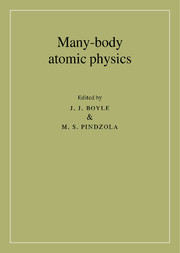Book contents
- Front Matter
- Contents
- Foreword
- Contributors
- Preface
- Acknowledgements
- Part 1 ATOMIC STRUCTURE
- Part 2 PHOTOIONIZATION OF ATOMS
- Part 3 ATOMIC SCATTERING: A. General Considerations
- 8 The many-body approach to electron-atom collisions
- 9 Theoretical aspects of electron impact ionization, (e, 2e), at high and intermediate energies
- Part 3 ATOMIC SCATTERING: B. Low-order applications
- Part 3 ATOMIC SCATTERING: C. All-order applications
- Appendix: Units and notation
- References
- Index
9 - Theoretical aspects of electron impact ionization, (e, 2e), at high and intermediate energies
Published online by Cambridge University Press: 22 September 2009
- Front Matter
- Contents
- Foreword
- Contributors
- Preface
- Acknowledgements
- Part 1 ATOMIC STRUCTURE
- Part 2 PHOTOIONIZATION OF ATOMS
- Part 3 ATOMIC SCATTERING: A. General Considerations
- 8 The many-body approach to electron-atom collisions
- 9 Theoretical aspects of electron impact ionization, (e, 2e), at high and intermediate energies
- Part 3 ATOMIC SCATTERING: B. Low-order applications
- Part 3 ATOMIC SCATTERING: C. All-order applications
- Appendix: Units and notation
- References
- Index
Summary
Introduction
Beginning with the pioneering experiments of Ehrhardt et al. and Amaldi more than 30 years ago, a field of considerable activity has developed in the area of measuring and theoretically predicting the angular and energy correlations of two electrons leaving an ion following ionization by electron impact, the so-called (e, 2e) problem. This field is daunting both experimentally and theoretically; the experiments require coincidence measurements with typically small counting rates while the adequate description of two light charged particles with modest kinetic energy moving in the Coulomb potential of a heavy ion, one version of the Coulomb three body problem, has provided a continuing challenge to theorists.
The underlying goal of this research has been to achieve a better understanding of the ubiquitous process of ionization by studying the basic process of an incoming electron transferring a measured amount of momentum to a target atom with the result that a secondary electron is ejected, its momentum being measured also. Such experiments then measure all kinematic variables and provide the most detailed information possible about the event. The only observable averaged over is the spin. A practical application of this activity is that, if theories can be developed to get these differential cross sections right, then integration should produce reliable total ionization cross sections which are in constant demand in other areas, astrophysics and the controlled fusion program for example.
In its several decade existence the (e, 2e) work has already spread into several subfields.
- Type
- Chapter
- Information
- Many-Body Atomic Physics , pp. 213 - 234Publisher: Cambridge University PressPrint publication year: 1998



